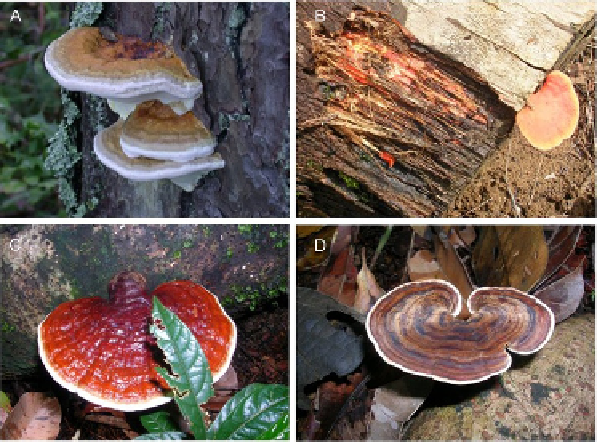Biology Reference
In-Depth Information
Fig. 1. (A) Typical aspect of wood-rotting fungi (Fomitopsis pinicola), a brown-
rot fungus; (B) typical aspect of wood degraded by a white-rot fungus (Pycnoporus
cinnabarinus); (C, D) two specimens of white-rot fungi Ganoderma sp. and Amaur-
oderma sp. (all photos from INRA/CIRM-CF, Marseille).
Pycnoporellus, Neolentinus and Paxillus;
Martinez et al., 2005; Ryvarden,
1991; Sanchez 2009
) and, to a lesser extent, Ascomycota (including Aspergil-
lus niger, Fusarium oxysporum and Fusarium merismoides;
Sanchez, 2009
).
BRF selectively strip cellulose and hemicelluloses from wood, which rap-
idly loses its strength properties. In advanced stages of decay, the rotten
wood is reduced to a residue of amorphous, crumbly, brown cubical pieces,
mainly composed of slightly modified lignins. As BRF do not produce
phenol oxidases, these residual lignins can be dealkylated, demethoxylated
and demethylated to some extent, but their aromatic rings are not degraded.
During brown-rot decay, degradation occurs at a great distance from
hyphae by diffusion of enzymes. BRF colonize wood tissues via the rays,
from where the hyphae ramify out into the axial wood structure, penetrating
through cells using pits or by bore holes (
Daniel, 2003
). The S2 layer of the
secondary wall is depolymerized preferentially to other layers, probably
owing to its reduced density and lower lignin content. At advanced stages
of decay, much of the S2 layer is severely degraded and metabolized. By
contrast, the more highly lignified primary wall and middle lamella generally
resist BFR attack.

